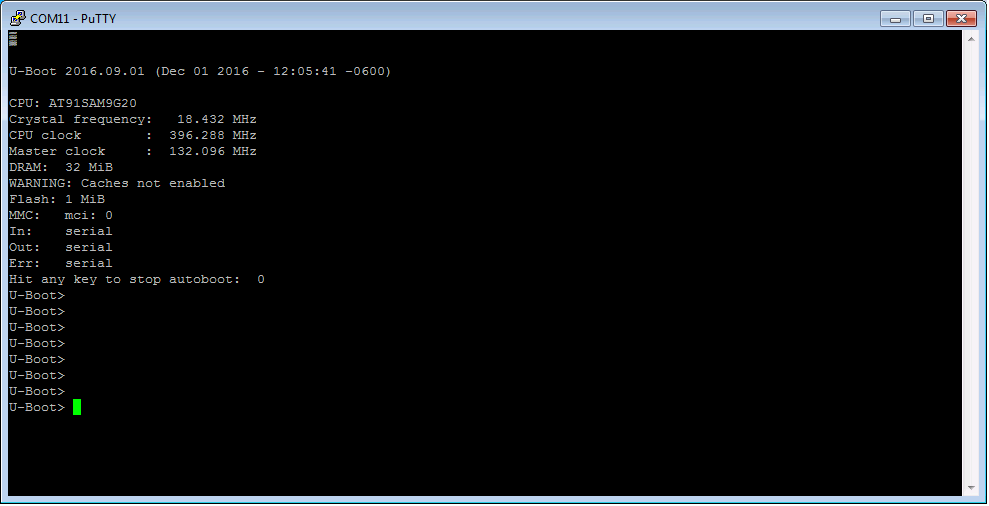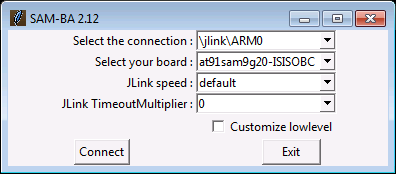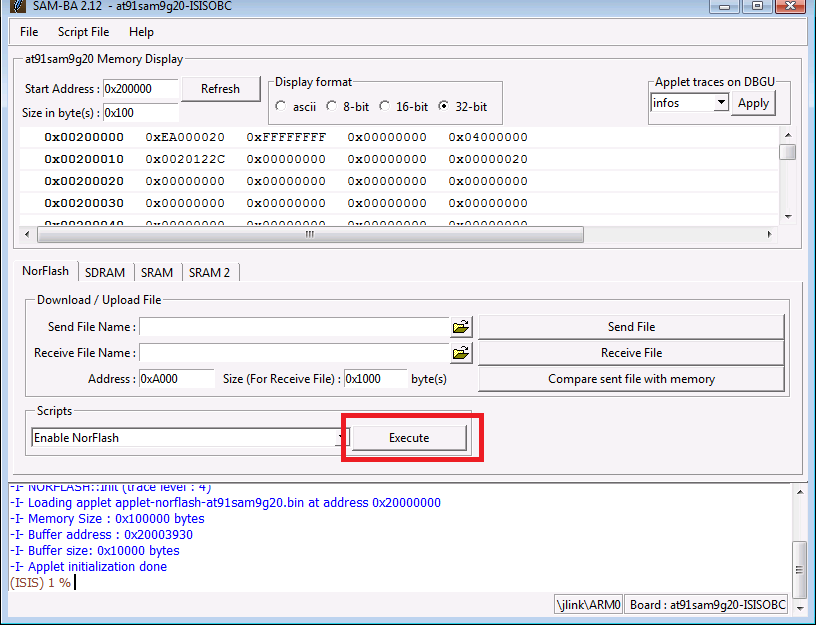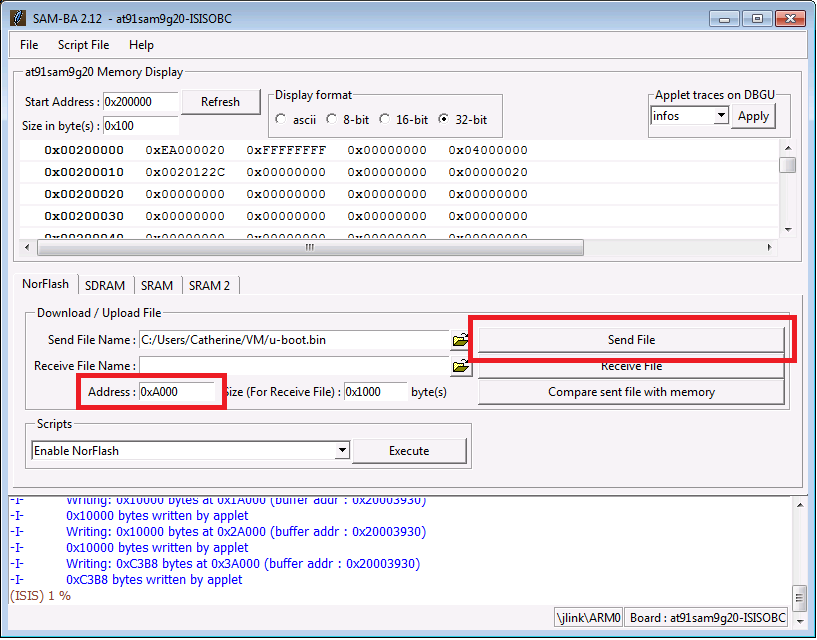Installing Kubos Linux on an ISIS-OBC¶
Overview¶
This document covers the steps required to install Kubos Linux onto an iOBC.
Reference Documents¶
iOBC Documentation¶
The ISIS-OBC Quickstart Guide should have been packaged with the iOBC and is a useful document for learning what each of the hardware components are, how to connect them, and what drivers need to be installed to support them.
Kubos Documentation¶
- Getting Started with KubOS and the Kubos SDK - Basic tutorial for creating your first SDK project
- Kubos SDK Cheatsheet - Overview of the common Kubos SDK commands
- Using Kubos Linux - General guide for interacting with Kubos Linux
- Working with the ISIS-OBC - Guide for interacting with iOBC-specific features
- Building Kubos Linux for the ISIS-OBC - Steps to build Kubos Linux
Components¶
The Kubos Linux installation process is composed of two high-level steps:
- Flashing the SD card
- Flashing the on-board NOR flash
To perform a default installation, three files are needed:
- A Kubos Linux SD card image
- u-boot.bin
- at91sam9g20isis.dtb
All of these files can be obtained from our Kubos Linux Releases page on GitHub
Download the latest Kubos_Linux.zip file and then unzip the files for the iOBC. They’re located in the Kubos_Linux/{version}/iOBC folder.
Install the SD Card Files¶
All users should install the SD card files using a distributed Kubos Linux image, unless they have created a custom Kubos Linux build. In that case, the SD card files can be installed by either flashing a complete Kubos Linux image onto an SD card or by alternate means.
Pre-Requisites¶
- Obtain an SD card that is at least 4GB.
Note
The Kubos Linux SD images are created for a 4GB SD card. The image can be applied to a larger SD card, but the resulting system will still only have 4GB of space available to it.
- Install Etcher. Other software to flash SD cards does exist, but Etcher is the Kubos software of choice.
- Obtain a Kubos Linux image
Flash the SD Card¶
Using Etcher:
- Select the Kubos Linux image to flash
- Make sure the SD card device is correct (may be auto-detected if there is only one SD card present in your system.)
- Click the “Flash!” button to start the flashing process

Etcher Setup
It should take roughly 10 minutes for a 4GB image to be loaded onto an SD card.
Once the program has finished successfully, the SD card is ready to be inserted into the iOBC’s SD Card 0 slot.
Install the NOR Flash Files¶
The NOR flash files will be loaded onto the iOBC using the Atmel SAM-BA software.
This can be done by using the provided command line script or using the SAM-BA GUI.
The SD card does not need to be inserted into the iOBC in order for this step to work.
Warning
The SAM-BA software currently only supports using the SAM-ICE JTAG with host machines running Windows. This means that you must use a Windows OS in order to initially flash the iOBC.
Note
Once Kubos Linux has been initially installed, future releases of the device tree can be installed using the Upgrade Installation process with a kpack-nor-*.itb file, rather than by manual flashing.
Pre-Requisites¶
Obtain an Atmel SAM-ICE programmer/debugger.
Install programming drivers from https://www.segger.com/jlink-software.html.
Install FTDI USB-to-serial drivers from http://www.ftdichip.com/Drivers/VCP.htm
Install SAM-BA from the ISIS-OBC SDK installer. (Refer to Section 3.3 of the ISIS-OBC Quick Start Guide)
Note: You must use the ISIS version of SAM-BA, rather than the default Atmel installation. It includes several configuration files that are required to connect to the iOBC.
Setup the iOBC board for serial connection and programming. (Refer to Chapter 4 of the ISIS-OBC Quick Start Guide)
Connect the programming and serial connection cables to your computer.
Warning
Make sure the red jumper on the programming board is in place; it bypasses the watchdog. If you don’t, the board will continually reboot and you won’t be able to flash anything.
Turn on the board.
Copy the kubos-nor-flash.tcl script from the tools/at91sam9g20isis folder in the kubos-linux-build repo into the SAM-BA application folder.
Change line 44 in {path to SAM-BA}/tcl_lib/boards.tcl from this:
"at91sam9g20-ISISOBC" "at91sam9g20-ISISOBC/at91sam9g20-ISISOBC.tcl"to this:
"at91sam9g20-isisobc" "at91sam9g20-ISISOBC/at91sam9g20-ISISOBC.tcl"(the SAM-BA application converts everything to lower case, which will lead to a “board not found” error if you don’t change this file)
Boot into U-Boot¶
(Skip this section if you’ve never put Linux on your board before)
If you already have Linux running on your board, you’ll need to boot into the U-Boot console rather than the Linux console in order to be able to flash the board.
You’ll need to establish a serial connection with the board in order to connect to the console.
You can do this via a Kubos SDK Vagrant image with the minicom kubos command
after booting the board.
The default login information for an iOBC is kubos/Kubos123.
Issue the reboot command in order to restart the system.
Hold down any key while the board is restarting. This will exit out of the auto-boot and bring up the CLI.

U-Boot Console
The board is now ready to be flashed.
Flash the Files¶
The flashing script can be called from the standard command prompt using this command:
$ {path to SAM-BA}/sam-ba.exe \jlink\ARM0 at91sam9g20-ISISOBC
{path to SAM-BA}/kubos-nor-flash.tcl {input arguments} [> {logfile}]
Where the input arguments are as follows:
- uboot={uboot file} - Path to U-Boot binary
- dtb={dtb file} - Path to Device Tree binary
- altos={alt file} - Path to alternate OS binary
Multiple input arguments can be specified and should be space-separated.
The optional logfile parameter is highly recommended, as the SAM-BA application will not give any other response to this command. The log file will contain all of the output as the script connects to the board and transfers the files.
Example command:
$ C:/ISIS/applications/samba/sam-ba.exe /jlink/ARM0 at91sam9g20-ISISOBC
C:/ISIS/applications/samba/kubos-nor-flash.tcl uboot=new-u-boot.bin dtb=new-dtb.dtb
> logfile.log
If you’d like to confirm that the command ran successfully, open the log file. You should see this message for each file you attempted to flash:
Sent file & Memory area content (address: [...], size: [...] bytes) match exactly !
Reboot the System¶
If you have not already done so, insert the SD card into the iOBC’s first SD card slot while the board is not powered.
After new files have been loaded, the board will need to be powered off and back on again in order to go through the normal boot process.
Using Kubos Linux¶
For information on how to create and run applications on your new Kubos Linux system, see the Working with the ISIS-OBC guide.
Non-Default Installation Process¶
There are alternate ways to install Kubos Linux onto the board, in case you want to create a custom installation, or are having issues with the default installation work flow.
Alternate SD Card Setup¶
If you do not have a Kubos Linux image, you can load the required files onto an SD card:
by using our flashing script
or
manually
Pre-Requisites¶
Since you are not using a pre-built Kubos Linux image, you will need to go through the OS build process locally in order to create the kernel and rootfs files.
In order to write the files to the SD card your build system needs be able to a) see the SD card device and b) read/write to multiple partitions.
If you’re running Mac OS or Windows, you’ll need to pass the SD card through to your Vagrant box.
If you’re running Linux, you can either pass through the SD card to your Vagrant box via the VirtualBox Manager, or run the whole build process natively.
Get the Device Name¶
To start, find the name of your SD card in your system:
$ sudo fdisk -l
You should see a device that looks like this:
Disk /dev/sdb: 3.8 GiB, 4025483264 bytes, 7862272 sectors
Units: sectors of 1 * 512 = 512 bytes
Sector size (logical/physical): 512 bytes / 512 bytes
I/O size (minimum/optimal): 512 bytes / 512 bytes
Disklabel type: dos
Disk identifier: 0xf39e6ab1
In this example ‘/dev/sdb’ is the name of the SD card. You might also see ‘/dev/mmcblk0’. You’ll need to use this name in all future commands.
Method 1: Run the Formatting/Flashing Script¶
A script is available to format the SD card and then load the latest Kubos Linux kernel and root filesystem.
Navigate to the ‘kubos-linux-build/tools’ directory.
Run the format-sd.sh script. You might need to run as root to get
permissions for certain steps.
The script has optional parameters:
-d {device}- Specify the name of the SD card device. The default is ‘/dev/sdb’-s {size}- Size, in MB, of the SD card. The default is 4000 (4GB).-w- Specify that the SD card should be wiped before formatting. Useful if there was any data previously on the card. Note Wiping a 4GB SD card takes about 10 minutes.-p- Specify that existing kpack-base.itb and kernel files should be copied into the appropriate partitions-pp- Specify that the kpack-base.itb and kernel files should be built and then copied to their partitions-ppp- Specify that the SD card should not be formatted. Only build and copy the kpack and kernel files.-b {branch}- Specify the branch name of U-Boot that has been built. The default is ‘master’. This option should not need to be used outside of development.
So if I wanted to wipe my SD card and then build and load the new kernel files, I would run:
$ ./format-sd.sh -wpp
Once the script has finished successfully, the SD card is ready to be inserted into the iOBC’s SD Card 0 slot.
Method 2: Manual Format/Flash Process¶
If for some reason you’d like to format the SD card and load the bare minimum files onto it manually, follow this process.
Partition the SD Card¶
First, you’ll need to set up the partitions on the SD card (for readability, we’ll be using device name ‘/dev/sdb’. Be sure to replace with the device name of your SD card):
Create a partition table
$ sudo parted /dev/sdb mklabel msdos y
Create the partitions
$ sudo parted /dev/sdb mkpart primary ext4 4M 3856M
$ sudo parted /dev/sdb mkpart extended 3856M 3996M
$ sudo parted /dev/sdb mkpart logical fat16 3856M 3876M
$ sudo parted /dev/sdb mkpart logical ext4 3876M 3896M
$ sudo parted /dev/sdb mkpart logical ext4 3896M 3996M
Configure the partitions (ex. /dev/sdb1)
$ sudo mkfs.ext4 /dev/sdb1
$ sudo mkfs.fat /dev/sdb5
$ sudo mkfs.ext4 /dev/sdb6
$ sudo mkfs.ext4 /dev/sdb7
Create the Kernel File¶
The BuildRoot build process creates the zImage file, which is a self-extracting kernel image. In order to help detect corruption, we package that into an *.itb file, which includes a checksum value that can be validated during boot time.
Navigate to your ‘kubos-linux-build’ folder and open the ‘tools’ directory.
Run the kubos-kernel.sh script.
The script has optional parameters (which are unlikely to be needed):
-i {input-file}- Specify the name of the *.its file to use. This file describes the files that will be packaged and their usage configuration options. The default is ‘kubos-kernel.its’, which should also be located in the ‘tools’ directory.-b {branch}- Specify the branch name of U-Boot that has been built. The default is ‘master’. This option should not need to be used outside of development.
The script will create the ‘kubos-kernel.itb’ file.
Copy the files¶
Next, you’ll need to copy the kernel file into the boot partition and the rootfs into the rootfs partition
From your project folder:
Create mount folders
$ mkdir boot
$ mkdir rootfs
Mount the partitions (replace ‘/dev/sdb’ with the name of your SD card device)
$ sudo mount /dev/sdb5 boot
$ sudo mount /dev/sdb6 rootfs
Copy the kubos-kernel.itb file into partition 5. It will need to be renamed to ‘kernel’.
$ sudo cp buildroot-2017.02.8/output/images/kubos-kernel.itb boot/kernel
Untar the rootfs into partition 6
$ sudo tar -xvf buildroot-2017.02.8/output/images/rootfs.tar -C rootfs
Unmount the partitions
$ sudo umount /dev/sdb5
$ sudo umount /dev/sdb6
Remove the SD card and insert it into iOBC SD card slot 0.
Alternate NOR Flash Setup¶
You must still use the Atmel SAM-BA software on a Windows machine in order to flash the required files into the iOBC NOR flash. However, you can use the SAM-BA software directly to do so, rather than using the previously provided script.
Pre-Requisites¶
Obtain an Atmel SAM-ICE programmer/debugger.
Install programming drivers from https://www.segger.com/jlink-software.html.
Install FTDI USB-to-serial drivers from http://www.ftdichip.com/Drivers/VCP.htm
Install SAM-BA from the ISIS-OBC SDK installer. (Refer to Section 3.3 of the ISIS-OBC Quick Start Guide)
Note: You must use the ISIS version of SAM-BA, rather than the default Atmel installation. It includes several configuration files that are required to connect to the iOBC.
Setup the iOBC board for serial connection and programming. (Refer to Chapter 4 of the ISIS-OBC Quick Start Guide)
Connect the programming and serial connection cables to your computer.
Warning
Make sure the red jumper on the programming board is in place; it bypasses the watchdog. If you don’t, the board will continually reboot and you won’t be able to flash anything.
Turn on the board.
Obtain the NOR flash files either from Kubos, or from your own local build:
- u-boot.bin
- at91sam9g20isis.dtb
Boot into U-Boot¶
(Skip this section if you’ve never put Linux on your board before)
If you already have Linux running on your board, you’ll need to boot into the U-Boot console rather than the Linux console in order to be able to flash the board.
You’ll need to establish a serial connection with the board in order to connect to the console.
You can do this via a Kubos Vagrant image with the minicom kubos command
after booting the board.
The default login information for an iOBC is kubos/Kubos123.
Issue the reboot command in order to restart the system.
Hold down any key while the board is restarting. This will exit out of the auto-boot and bring up the CLI.

U-Boot Console
The board is now ready to be flashed.
Installation¶
Start SAM-BA¶
Start up SAM-BA. You’ll want to select the at91sam9g20-ISISOBC option from the ‘Select your board’ drop-down.

SAM-BA Connection Selection
Enable Flashing¶
Execute the ‘Enable NorFlash’ script. This will prep the board to enable flashing.

SAM-BA Enable NorFlash
Flash U-Boot¶
Select the uboot.bin file in the ‘Send File Name’ field.
Make sure that ‘Address’ is set to 0xA000.
Click ‘Send File’

SAM-BA Send U-Boot
Click ‘Compare sent file with memory’ after the file transfer has completed to confirm that all data was sent successfully.
Flash Device Tree¶
Select the at91sam9g20isis.dtb file in the ‘Send File Name’ field (you’ll need to view all file types in order to see the .dtb file)
Set ‘Address’ to 0x70000.
Click ‘Send File’

SAM-BA Send DTB
Click ‘Compare sent file with memory’ after the file transfer has completed to confirm that all data was sent successfully.
Reboot the System¶
After new files have been loaded, the board will need to be powered off and back on again in order to go through the normal boot process.